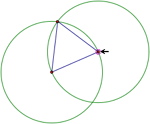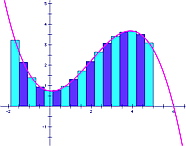The Sketchpad Story
The origins of The Geometer's Sketchpad date back to the 1980s and to the Visual Geometry Project, a research project at Swarthmore College under the direction of Drs. Eugene Klotz and Doris Schattschneider. This project, funded by the National Science Foundation, aimed to develop new technology-based materials for use in the teaching of geometry. Under its umbrella, Nicholas Jackiw pioneered the development of the first version of The Geometer's Sketchpad. The program's name honors Ivan Sutherland's 1963 SKETCHPAD program, a groundbreaking early work in interactive computer graphics (Sutherland, 1963).
Dynamic Geometry
 Key Curriculum Press became involved as the project's publisher. Key's founder and CEO, Steven Rasmussen, was the first to see that Jackiw's technique for interactively manipulating mathematical diagrams while maintaining their fundamental definitions had broad educational potential as a tool for mathematical visualization, generalization, conjecturing, and problem-solving. Rasmussen and Jackiw invented the term "Dynamic Geometry" to describe Sketchpad's fundamentally-interactive geometric imagery. After several years of development in the academic setting, Sketchpad underwent a year-long field-test in schools across the United States, and in 1991, the first commercial Macintosh version was released by Key Curriculum Press.
Key Curriculum Press became involved as the project's publisher. Key's founder and CEO, Steven Rasmussen, was the first to see that Jackiw's technique for interactively manipulating mathematical diagrams while maintaining their fundamental definitions had broad educational potential as a tool for mathematical visualization, generalization, conjecturing, and problem-solving. Rasmussen and Jackiw invented the term "Dynamic Geometry" to describe Sketchpad's fundamentally-interactive geometric imagery. After several years of development in the academic setting, Sketchpad underwent a year-long field-test in schools across the United States, and in 1991, the first commercial Macintosh version was released by Key Curriculum Press.
Sketchpad Beyond Geometry
 Since this beginning almost twenty years ago, continual development and improvement has kept The Geometer's Sketchpad at the forefront of educational technology innovation in school mathematics. Scott Steketee joined the development team, and with the support of IBM's EduQuest division, Key produced a version of Sketchpad for Microsoft Windows in 1993. In 1995 a third version broadened the scope of the program from Euclidean and transformational geometry to include analytic geometry. More significant changes came in 2001, when the fourth version of Sketchpad extended Dynamic Geometry to the teaching and learning of algebra and calculus as well. With these changes, as well as improvements in its ability to act both as an environment for student exploration and as a tool for curricular activity design and development, Sketchpad is now widely used across a broad spectrum of mathematical topics and age levels.
Since this beginning almost twenty years ago, continual development and improvement has kept The Geometer's Sketchpad at the forefront of educational technology innovation in school mathematics. Scott Steketee joined the development team, and with the support of IBM's EduQuest division, Key produced a version of Sketchpad for Microsoft Windows in 1993. In 1995 a third version broadened the scope of the program from Euclidean and transformational geometry to include analytic geometry. More significant changes came in 2001, when the fourth version of Sketchpad extended Dynamic Geometry to the teaching and learning of algebra and calculus as well. With these changes, as well as improvements in its ability to act both as an environment for student exploration and as a tool for curricular activity design and development, Sketchpad is now widely used across a broad spectrum of mathematical topics and age levels.
The project team at KCP Technologies, still led by Jackiw, balances ongoing development and maintenance of the software in a variety of configurations (including Java and handheld versions) with longer-term research into potential mathematical, pedagogical, and technological innovations for Sketchpad. Much of this research continues to be sponsored by the National Science Foundation, and is conducted in collaboration with educators, educational researchers, and mathematicians across the globe.
Sketchpad Across Mathematical Curriculum, Across the World
Today, Sketchpad is one of the most widely-used educational technologies for school mathematics in the world. Many textbooks and supplemental activities have been designed to take advantage of the software in diverse classroom settings. (Key Curriculum Press publishes more than a dozen Sketchpad-specific activity books.) Academic research has found that Sketchpad use has positive impact on student achievement (Battista, 2002; Hollebrands, 2007), conceptual understanding (Frekering, 1994), motivation and engagement (Sinclair, 2006). A large-scale assessment of technology trends in American education, conducted by researchers at the University of California, reports that mathematics teachers across the country find Sketchpad to be "the most valuable software for students"—and they agree more on this opinion than teachers in any other discipline agree on their most valued technology tools (Becker, 1999). The National Council for Teachers of Mathematics' Standards explicitly recommends the use of Dynamic Geometry at several grade levels (NCTM, 2000).
Outside the USA, Sketchpad is translated into many languages and widely used in Canada, China, Singapore, Russia, Korea and many other countries, where it is often integrated directly into the curriculum. In numerous localities, the software is nationally or provincially adopted, for school and student home use. Each new school year, tens of millions of students around the globe encounter mathematics through Sketchpad's Dynamic Geometry.
The Many Uses of Sketchpad
Beyond school mathematics, Sketchpad also finds application in pre-service teacher preparation, mathematical research, and in contexts as varied as structural engineering, optometry, science education, and the visual arts. The software has also received numerous industrial awards, and has been featured in presentations given by John Sculley (then CEO of Apple Computer) and Bill Gates (CEO of Microsoft) about best educational technology practices.
References
- Battista, Michael T. Shape Makers: A Computer Environment That Engenders Students’ Construction of Geometric Ideas and Reasoning. Computers in Schools, 17(1/2), (2002): 105–120.
- Becker, H. J.; Ravitz, J.; and Wong, Y. Teaching, Learning and Computing National Survey , University of California, Irvine: Center for Research on Information Technology and Organizations (1999).
- Frekering, B. G.. Conjecturing and Proof-Writing in Dynamic Geometry PhD Thesis, Georgia State University (1994).
- Hollebrands, Karen. "The Role of a Dynamic Software Program for Geometry in High School Students' Understandings of Geometric Transformations." Proceedings of the 24th Annual Meeting of the North American Chapter of the International Group for the Psychology of Mathematics Education, Columbus, Ohio: ERIC (2007): 695-705.
- National Council of Teachers of Mathematics. Principles and standards for school mathematics Reston: National Council of Teachers of Mathematics (2000).
- Sinclair, N. Mathematics and Beauty: Aesthetic Approaches to Teaching Children, New York: Teachers College Press (2006).
- Sutherland, Ivan E. Sketchpad: A man-made graphical communication system, Ph.D. Thesis. courtesy Computer Laboratory, Unversity of Cambridge (January 1963 and September 2003).